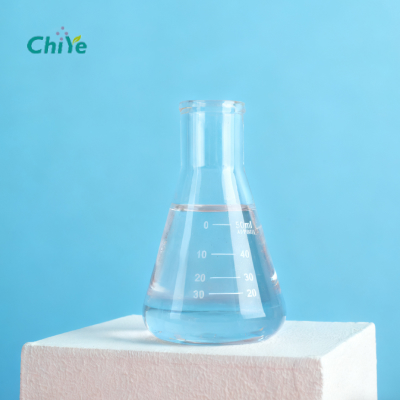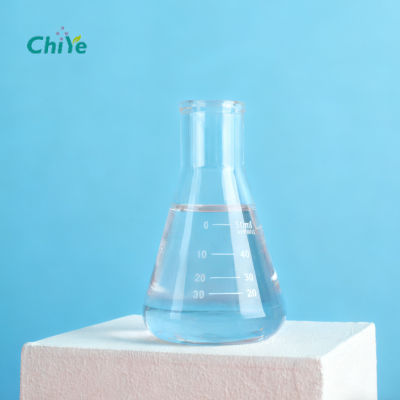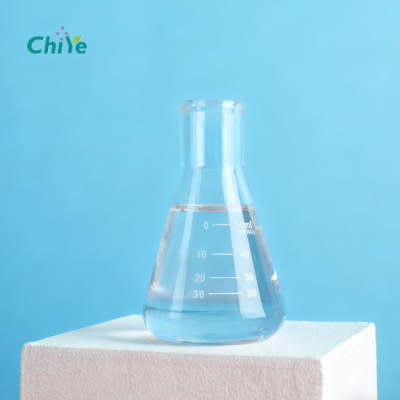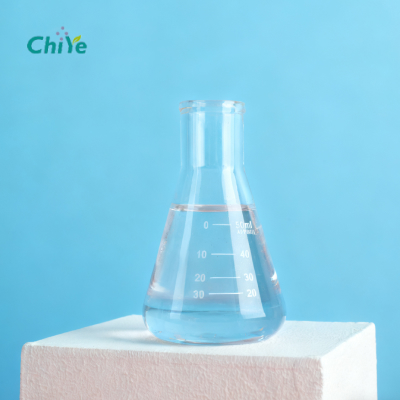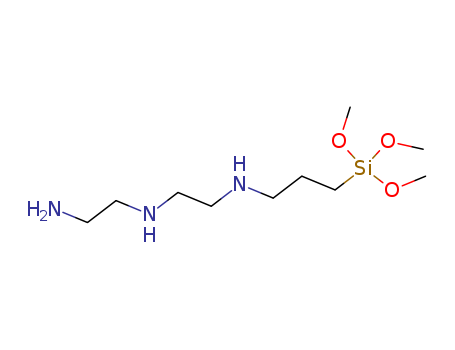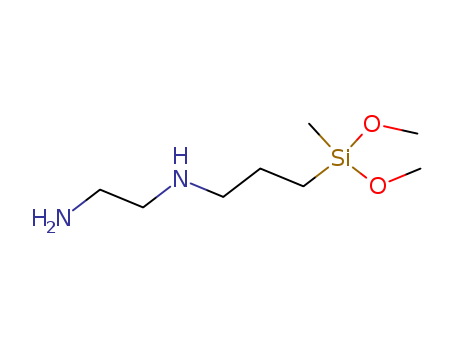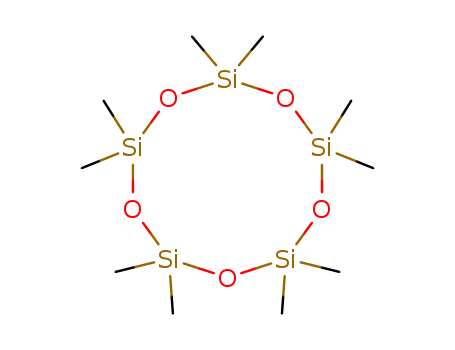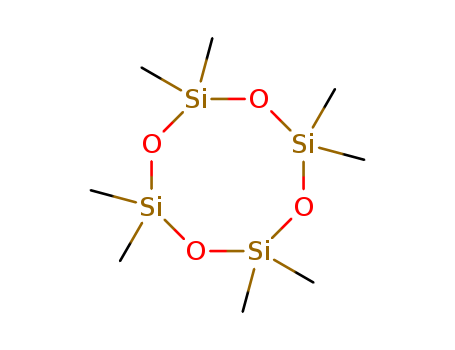
556-67-2
- Product Name:Octamethylcyclotetrasiloxane (D4)
- Molecular Formula:C8H24O4Si4
- Purity:99%
- Molecular Weight:296.618
Product Details
Chinese Manufacturer supply Octamethylcyclotetrasiloxane (D4) 556-67-2 in stock with high standard
- Molecular Formula:C8H24O4Si4
- Molecular Weight:296.618
- Appearance/Colour:Colorless clear liquid
- Vapor Pressure:1.57mmHg at 25°C
- Melting Point:17-18 °C(lit.)
- Refractive Index:n20/D 1.396(lit.)
- Boiling Point:175 °C at 760 mmHg
- Flash Point:63.2 °C
- PSA:36.92000
- Density:0.95 g/cm3
- LogP:2.87360
Octamethylcyclotetrasiloxane(Cas 556-67-2) Usage
|
Preparation |
Commercially Octamethylcyclotetrasiloxane is produced from dimethyldichlorosilane. Dimethyldichlorosilane is added dropwise to water, the temperature is maintained at 30-40°C, stratified, the acid water is released, the oily material is hydrolyzed with sodium hydroxide solution, the hydrolysate and 0.5%-2% potassium hydroxide are added to the cracking kettle and cracked at 120-140°C and 99.8 kPa vacuum. The cracked material is fractionated and the fraction is collected at 173-176°C to obtain octamethylcyclotetraoxysilane. |
|
Health Hazard |
Octamethylcyclotetrasiloxane (D4) can interfere with the body’s hormones. In animals, it can affect the reproductive system.D4 is classified as a category 1 endocrine disruptor by the European Commission. A 2018 study commissioned by the Danish EPA identified D4 as an endocrine disruptor. The Global Harmonized System Label Requirements classified D4 as suspected to produce reproductive toxicity. D4 was added to the Toxic Substances Control Act work plan due to reproductive toxicity, moderate environmental persistence, and high bioaccumulation potential.Adverse reproductive effects including estrogenic effects have been observed in rodents. The European Chemicals Agency characterized D4 as a persistent, bioaccumulative, and toxic chemical, and designated D4 as a Substance of Very High Concern. |
|
Flammability and Explosibility |
Flammable |
|
Purification Methods |
The solid exists in two forms, m 16.30o and 17.65o. Dry it over CaH2 and distil it. Further fractionation can be effected by repeated partial freezing and discarding the liquid phase. [Osthoff & Grubb J Am Chem Soc 76 399 1954, Hoffman J Am Chem Soc 75 6313 1953, Beilstein 4 IV 4125.] |
|
Definition |
ChEBI: Octamethylcyclotetrasiloxane is a cyclosiloxane that is the octamethyl derivative of cyclotetrasiloxane. It is an organosilicon compound and a cyclosiloxane. It derives from a hydride of a cyclotetrasiloxane. |
|
General Description |
Octamethylcyclotetrasiloxane (D4) is a volatile methylsiloxane (VMS) with a relatively low molecular weight. This silicone fluid has a silicon-oxygen bond in a cyclic arrangement and methyl groups are attached to the silicon atom. D4 can be used in the manufacture of silicone based polymers for use in medical devices and personal care products. |
InChI:InChI=1/C8H24O4Si4/c1-13(2)9-14(3,4)11-16(7,8)12-15(5,6)10-13/h1-8H3
556-67-2 Relevant articles
Silylating Disulfides and Thiols with Hydrosilicones Catalyzed by B(C6F5)3
Brook, Michael A.,Liao, Mengchen,Zheng, Sijia
supporting information, p. 2694 - 2700 (2021/06/25)
Hydrosilanes and silicones, catalyzed wi...
Hydrogenolysis of Polysilanes Catalyzed by Low-Valent Nickel Complexes
Comas-Vives, Aleix,Eiler, Frederik,Grützmacher, Hansj?rg,Pribanic, Bruno,Trincado, Monica,Vogt, Matthias
supporting information, p. 15603 - 15609 (2020/04/29)
The dehydrogenation of organosilanes (Rx...
Heterocyclization and solvent interception upon oxidative triflamidation of allyl ethers, amines and silanes
Ganin, Anton S.,Moskalik, Mikhail Yu.,Astakhova, Vera V.,Sterkhova, Irina V.,Shainyan, Bagrat A.
, (2020/07/20)
The reactions of triflamide with a serie...
METHOD FOR PRODUCING SILOXANE OLIGOMER
-
Paragraph 0034; 0045, (2017/07/23)
PROBLEM TO BE SOLVED: To provide a produ...
556-67-2 Process route
-

- 3277-26-7
1,1,3,3-Tetramethyldisiloxane

-

- 1111-74-6
dimethylsilane

-

- 1438-82-0
1,1,1,3,3-pentamethyl-1,3-disiloxane

-

- 1189-93-1
1,3,3,5,5-hexamethyltrisiloxane

-

- 541-05-9
Hexamethylcyclotrisiloxane

-

- 1000-05-1
1,1,3,3,5,5,7,7-octamethyltetrasiloxane

-

- 556-67-2
octamethylcyclotetrasiloxane

-

- 19095-23-9
1,1,3,3,5,5,7,7,9,9,11,11,13,13-tetradecamethylheptasiloxane

-

- 995-83-5
1,1,3,3,5,5,7,7,9,9-decamethylpentasiloxane

-

- 995-82-4
1,1,3,3,5,5,7,7,9,9,11,11-dodecamethylhexasiloxane
| Conditions | Yield |
|---|---|
|
|
-

- 1450-14-2
1,1,1,2,2,2-hexamethyldisilane

-

- 60-29-7,927820-24-4
diethyl ether

-

- 75-77-4
chloro-trimethyl-silane

-

- 993-07-7
trimethylsilan

-

- 1825-62-3
ethyl trimethylsilyl ether

-

- 107-46-0
Hexamethyldisiloxane

-

- 556-67-2
octamethylcyclotetrasiloxane
| Conditions | Yield |
|---|---|
|
With hydrogenchloride; at 100 ℃; for 15h; Sealed tube;
|
556-67-2 Upstream products
-
60-29-7

diethyl ether
-
4095-10-7

dimethyldibromosilane
-
78-62-6

diethoxy dimethylsilane
-
75-78-5

dimethylsilicon dichloride
556-67-2 Downstream products
-
18236-23-2

bis-(2-methoxy-ethoxy)-dimethyl-silane
-
18001-62-2

1,3-bis-(2-methoxy-ethoxy)-1,1,3,3-tetramethyl-disiloxane
-
107-51-7

octamethyltrisiloxabe
-
18759-78-9

1,11-bis-(2,4-dichloro-benzoyloxymethyl)-1,1,3,3,5,5,7,7,9,9,11,11-dodecamethyl-hexasiloxane
Relevant Products
-
Diethylenetriaminopropylmethyldimethoxysilane
CAS:35141-30-1
-
3-(2-Aminoethyl)-aminopropylmethyldimethoxysilane
CAS:3069-29-2
-
Decamethylcyclopentasiloxane (D5)
CAS:541-02-6

